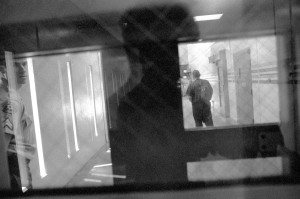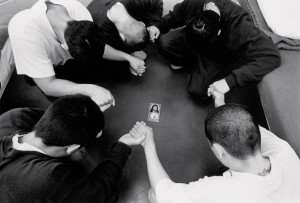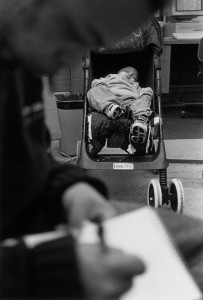
Photo by Ara Oshagan
NEW YORK -- As Ara Oshagan rocked his first-born son to sleep he prepared to meet monsters.
While he bounced and cooed his boy, Sebouh, to sleep to the achingly plaintive melody of Beethoven’s Moonlight Sonata he was the image of a doting father, but in his mind he was quietly bracing himself to meet some of what many considered to be California’s youngest and most dangerous criminals.
The geo-physicist turned documentary photographer had never been behind the walls of the juvenile detention facilities that dot the outskirts of Los Angeles along the spine of Interstate 5 in the Central Valley, but the following morning he was going to take his camera, walk in, and take pictures of killers and gangsters.
“I expected the worst,” he said. “The worst of the worst; The ones glaring at you in those orange jumpsuits. You see how they’re portrayed. I expected them to be standoffish, imminently violent, unstable. Ready to do anything.”
What he encountered subverted his anxious expectations. He found a teenager, a piano prodigy before he was tried as an adult and put behind bars. The young inmate was tinkering with an electric piano, and in the grey gloom of the facility echoed the same funereal, haunting sonata he heard in the comfort of his son’s nursery the evening before. The inmate played Beethoven with precision and feeling.
“What I met weren’t monsters,” Oshagan, now 47, said. “They were normal kids. I knew the system wasn’t working -- I didn’t know exactly how bad it was until I started talking to these kids and seeing what happens to them.”

Photo by Ara Oshagan
The pictures Oshagan took that day and for years after from 2001 to 2005, are part of a exhibition called “Cruel and Unusual” on display inside a massive 40-foot long shipping container stacked on the uplands of Pier 3 along the Waterfront in Brooklyn. The show features a collection of pictures by photographers from across the country chronicling life behind bars, some of which were gathered by co-curator Pete Brook during what he calls the Prison Photography on the Road.
Brook hopes the people who come to see the pictures will undergo the same sort of transformation that Oshagan did when he started his project.
“This installation doesn’t come close to describing the problems with the system and the need for reform,” he said. “But for many people who are uninformed with the subject matter I’m hoping it will be a jolt, an awakening, and a reason to go look deeper into these issues under their own steam.”
“Cruel and Unusual,” named ironically after the Eighth amendment (and, Brook notes, written into the English Bill of Rights in 1689) is part of a larger exhibit, described by its organizers as a “photography destination” called Photoville -- a 60,000 square-foot village featuring 30 containers with exhibitions ranging from the photojournalistic to the playful and bombastic, hands-on workshops, projections and lectures open from June 22 to July 1.

Photo by Joseph Rodriguez
Last year, Brook and fellow blogger and curator Hester Keijster began talking about assembling an installation to showcase the work that so many photographers were doing to document the life of prisoners and the system of corrections. They curated a show in Noorderlicht, a gallery in Groningen, a town in northern Netherlands. The gallery decided to send “Cruel and Unusual” as its contribution to Photoville.
Brook, who started a blog featuring prison photography in October, 2008, said he became interested in prison reform when he started researching his master’s thesis on a prison museum in San Quentin. A native of England, who grew up in Lancashire, Brook said he does not want to be perceived as an outsider chastising the United States for what he sees as a deeply flawed prison system.
On a recent morning sweat dripped from Brook’s face as he put the finishing touches on the installation. He scrawled facts and quotes directly onto the grey sides of the containers, the red and black markers squeaking on the corrugated metal. Above him a string of bulbs casting a wan glow hung from the roof. He wore a pair of tan cut-off shorts, a T-shirt with a picture of faded palm trees and some scuffed black scandals. He blended in well with the gritty, frill-less presentation of the work -- raw, bleak photos taped to the wall without the formality of staged lighting and frames.

Pete Brook. Photo by Jack Jeffries
“Cruel and Unusual” is like looking at a fractured dimension of real life; A parallel universe much like ours but taking place behind bars. It captures the full range of the human experience, but rigidly contained to barren cells and cramped hallways.
There’s a pregnant woman, her swollen belly poking out of her prison issue clothes. Four couples beam at the camera, newlyweds, women who married serving time with no parole, who will never have an opportunity to consummate their relationship. Men squat in a circle around a small picture of Jesus with a heart engulfed in flames in a pantomime of a structured religious service. Grim faced men in Louisiana’s Angola state prison push a gurney toward the hospital ward to collect a corpse.
And then there are the young. In a number of pictures, the insecurity and confusion of adolescence is played out in rusty cells and behind thick security gates. In one shot, a boy swimming in his prison-issued uniform stares up at a wall inside a daunting metal cell that dwarfs him. In another, a girl hides her face behind her long blonde hair sitting on her bed.
Joseph Rodriguez, 61, who also has pictures of juveniles on display, said he was once one of those youths. He was arrested in Brooklyn for a number of minor charges. His mother
couldn’t afford the bail so he was shipped off to Riker’s Island. Rodriguez said there wasn’t a juvenile wing back then. He shared a cell with a 38-year-old man. He thought about suicide.

Photo by Joseph Rodriguez
“It smacked me in the face the minute I walked in there,” he said. “It’s a life that people don’t understand. Anything that is humane is thrown out the window. Handcuffed, strip searched, a million guys trying to hustle you, you are challenged the minute you walk in the door.”
He said he knows the pictures that he takes now as a documentarian won’t be enough alone to change the system, but for him it was the camera where he found salvation.
“I’m standing there in the darkness, the darkest place of my life; you can see it in the letter I write to my mother. I said I want to change myself. When I got out I got a camera. I went from shooting drugs to shooting pictures. It saved my life, man.”
Oshagan, now a father of four, said working with juvenile inmates changed how he looked at himself as a parent. He always told himself that his children were different, special, an attitude he said he shared with many doting parents.
But after spending time with juvenile inmates, seeing their curiosity about photography, and their sense of humor and watching them weep when they talked about the mistakes they made he said he realized they weren’t monsters. In fact, he said, they weren’t that different than his own children.
“I could see the potential of, you know, ‘my kid could be like that,’” he said. “You can see these are really good kids and you can’t believe that they are where they are. And then you understand how it is that one little thing got them here. One thing. You can imagine your own kid making one stupid mistake. It opened my eyes. Anything is possible.”
Photo of Pete Brook by Jack Jeffries

Great article!! The perception of people in prison and how our prison system works really needs to be reassessed.